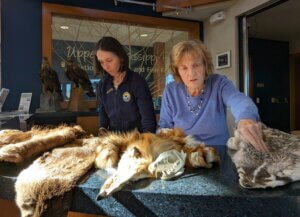Wildlife refuge an emblem of conservation success
June 8, 2024
| By La Crosse Community Foundation |
Friends of the Refuge — Mississippi River Pools 7 & 8

Karrie Jackelen (left) and Kathryn Lammers (right) organize furs and skulls of animals that can be found in the Upper Mississippi River National Wildlife and Fish Refuge, established 100 years ago this June. Both are volunteers with Friends of the Refuge — Mississippi River Pools 7 & 8, working to ensure the refuge remains for future generations.
As the Upper Mississippi River National Wildlife and Fish Refuge celebrates its 100th anniversary, it’s an emblem of conservation success along Wisconsin’s western border. The longest contiguous river refuge in the continental U.S., it offers sanctuary to diverse wildlife and provides over 3.7 million annual visitors with unparalleled opportunities for hunting, fishing, and immersing in the tranquility of its backwaters, marshes, and forests.
The Friends of the Refuge — Mississippi River Pools 7 & 8 (FOR78) play a critical role in protecting this natural environment. The group serves as a bridge between the refuge’s La Crosse District and surrounding communities, building awareness, enjoyment and support of the refuge through engagement, environmental experiences, education, and habitat enhancement. Through their work, they’re helping ensure the refuge remains a cherished resource for generations to come.
Kathryn Lammers is among those friends of the refuge, serving as secretary on the board of directors and 100th anniversary coordinator for FOR78.
What makes the Upper Mississippi River National Wildlife and Fish Refuge extraordinary?
Stretching 261 river miles from Wabasha, Minnesota to Rock Island, Illinois, the Upper Mississippi River National Wildlife and Fish Refuge has protected more than 240,000 acres of Mississippi River floodplain since 1924. The refuge is a Wetland of International Importance and a Globally Important Bird Area. It is divided into four districts: Winona District, La Crosse District, McGregor District, and Savannah District. The refuge is a critical element of the Mississippi Flyway, and its many wooded islands, sloughs, hardwood forests and open waters provide habitat for an amazing variety of plants, fish, birds, and wildlife. Recreational activities lure almost four million visitors to the Upper Mississippi River National Wildlife and Fish Refuge every year, which provides an economic boost to the communities along the river.
What role did social capital play in the area becoming a refuge and now in preserving it?
Social capital is the only reason the Upper Mississippi River became a National Wildlife and Fish Refuge. Without social capital, the floodplain would have been ditched and drained into a mere shadow of its former self, serving no role for fish and wildlife and only serving people as farmland that floods periodically. (Later on, the locks and dams were built.) Wil Dilg, a dedicated fisherman on the river and an unemployed liquor salesman (due to Prohibition), played a significant role. He worked through the Isaac Walton League to rally outdoor sportspersons and environmentalists to speak up for creation of the refuge. Today, FOR78 contributes to social capital which helps protect the refuge.
What legacy does the Friends of the Refuge aim to leave for future generations?
Public engagement is crucial for maintaining support and funding of the refuge on a long-term basis. Our focus is the La Crosse District, which encompasses the land and waters of the refuge between Lock and Dam #6 in Trempealeau, Wisconsin, and Lock and Dam #8 in Genoa, Wisconsin. We hope to nurture a legacy of lasting public engagement by creating opportunities to experience the refuge, learn about it, and enjoy it. The organization will need to continue to evolve to meet the changing needs of the refuge and the public, which will require board members who understand the mission but can also continue to adapt to changing times.
